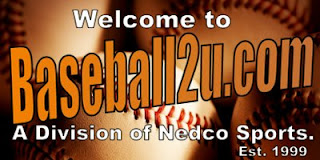By guest author: Nick Dixon
Every baseball player loves to hit the ball hard and far. The power required to hit the baseball deep comes from the generation of maximum bat speed. The generation of bat speed is created by the correct use of the lower body, hips and hands. Four key elements are required to make the batting swing more powerful. This article outlines and explains those key elements.Those key elements are:
1) The Batter Uses the Front Leg as Leverage to Generate Maximum Bat Speed. - What is leverage in the baseball swing? Why is leverage important? How is leverage generated? Leverage in a baseball swing is a resistance point or stationary object that stops forward movement. The front foot acts as the lever and provides leverage to the swing. For this leverage to occur the batter must allow the ball pass front foot. The front foot should be closed with the toes pointed toward the plate to supply maximum leverage to the swing. This leverage is the force against which the batter rotates the hips against. The front leg must be strait and planted to allow the hips to turn.
2) The Batter Generates Maximum Rotational "Torque of the Hips". - I use the term "Hip Torque" to describe the power the hips add to the swing. Batters must rotate the hips to achieve maximum bat speed. To get the maximum hip turn the front foot should be kept in a closed position. If the front foot is allowed to rotate or is in an open position at any point during the swing, there will be a loss of hip energy and a reduction of power in the swing.
The back foot is often lifted or turned up onto the toe. Many coaches describe the action of the back foot as a turn of the "shoe laces to the pitcher". The back foot action is not nearly as important as the front foot. The one thing that must be monitored is that the back foot does not travel forward. The back foot should stay where it was at the beginning of the swing, but the heel should lift and the foot turn to free the back side and to allow for maximum hip and torso rotation.
3) The Batter Keeps of the Hands Close to the Body. The Batter Keeps the Hands on the Shortest Power Path to the Ball. - The power track for the hands is a path that starts above the ball and close to the body. The "power track" is a short compact swing that is directly to the ball. To generate great bat speed the batter must drive the knob and bury it at the power contact position. Keeping the hands closer to the body also keeps the hands inside the ball.
4) The Batter Achieves Maximum Extension Through the Ball. - The batter that keeps the bat on the ball plane as long as possible is able to generate the maximum amount of power possible. The track or path of the bat should be downward until it gets to the balls plane. When the bat gets on an even plane with the ball, the batter should then drive the hands forward through the ball. This power extension has the top hand in a palm down position and the bottom hand in a palm up position. This forward extension or drive through the baseball is a key element of generating power.
I hope that this article was informative and helpful to you. I appreciate you taking the time to read. Have a great day, Nick.
The CoachesBest Baseball Store has a great selection of 1400 Baseball Products. Check out the BatAction Hitting Machine baseball pitching simulator. This high speed training machine is 100% Guaranteed to raise Batting Averages and has a full year warranty.
Nick Dixon is the President and founder of Nedco Sports, a sports training company established in 1999. Dixon is also an active and full time high school baseball coach with over 25 years experience. Coach Dixon is better known as the inventor of the BatAction Hitting Machine, the SKLZ Derek Jeter Hurricane Hitting Machine, the SKLZ Target Trainer, the SKLZ Derek Jeter ZipnHit Pro, and the SKLZ Strikeback Trainer. Dixon is also a contributing writer for BaseballCoachingDigest, the Youth Baseball Digest, the Baseball Parent Guide, the Baseball 2Day Coaches Journal, and Blog4Coaches.
Article Source: http://EzineArticles.com/?expert=Nick_Dixon
=====================
Thanks to our sponsors:
www.BatAction.com

---BatAction Machine at CoachesBest.com
---BatActionMachine on Ebay.com
---BatAction Machine Video Clips
---BatAction Trainer - 15 Reasons Why You Must Own This Machine
---Message to Parents From Coach Nick
---If you are looking for BatAction Replacement Balls or Power Bands Click Here


